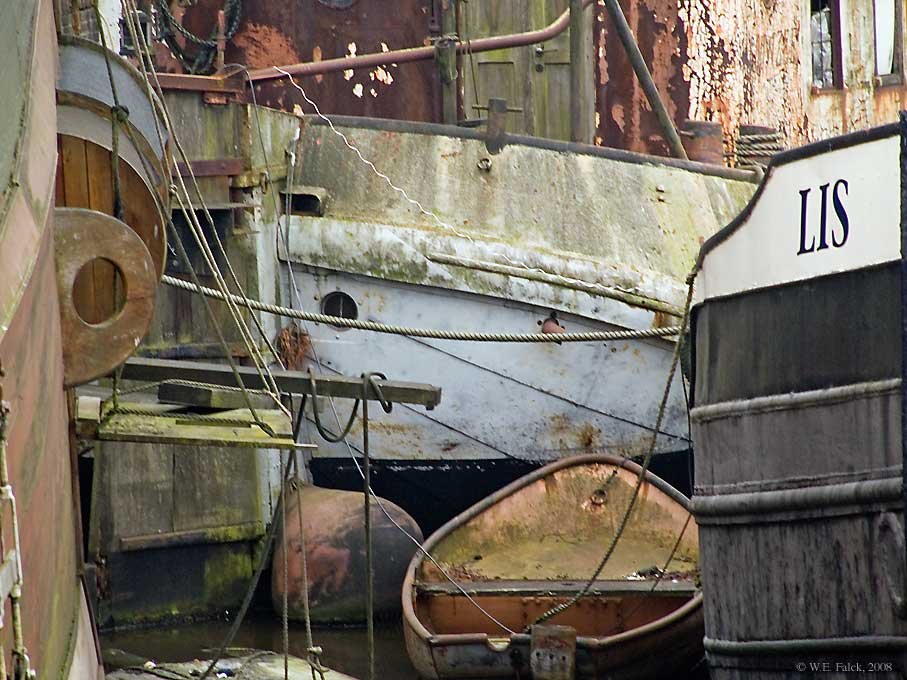-
Posts
6,532 -
Joined
-
Last visited
Content Type
Profiles
Forums
Gallery
Events
Everything posted by wefalck
-
A systematic approach always helps !
-

Scottish Maid (Artesania kit) - where to anchor etc braces
wefalck replied to gthursby's topic in Masting, rigging and sails
I think the model in the link above is one I seem to remember, not the 'seaman's' style one. -
Just running a couple of ropes across a boat sitting upright on chocks may not be sufficient to keep the boat from rocking. Today, so-called gripes are used, these are hooks that go over the wales and have an eye at the end. A rope is reefed in several turns through this eye and an eye-bolt or something suitable on the deck or the chocks. This rope then is fastened on itself after hauling it taut. Instead of hook, this rope could also be fastened to a suitable structural member inside the boat. The idea is to secure the boat at four points, rather than just pulling it down onto the chocks. Small boats that are relatively easily man-handled may be also better stored upside-down to keep them dry and to prevent overcoming water to collect in them in making them top-heavy.
-
It's coming on nicely. Somehow, the boat looks, as if mixes 19th and 18th century features, the bow looks still quite 18th century in shape.
- 69 replies
-
- Galway hooker
- fishing
-
(and 2 more)
Tagged with:
-
Good job on something, that can go easily wrong in different ! Yes, Christmas will be rather different this year, with no family gatherings in many parts of the world - even when legally possible, one should refrain anyway, as the whole society will pay for it in the end. We normally travel to Germany to spend Christmas with relatives, including my 95 year old mother - we wouldn't even get there, let alone be allowed to visit her ... very sad.
-
Red ochre, iron-oxyhydroxide (FeOOH ... I am a geochemist ) is rather stable in most environments. Its the same mineral the colours red sandstones and also a component of most iron-ores. So it is not terribly surprising that it may outlast wood. Depending on the actual composition of the mineral and heating processes during the pigment production, it's colour can vary from a pale orange to deep red to a reddish violett. Assuming that no a very high-quality pigment was used in 'barn-paints' a brownish red is probably the most likely colour.
-

Scottish Maid (Artesania kit) - where to anchor etc braces
wefalck replied to gthursby's topic in Masting, rigging and sails
The small reproductions of MacGregor's plans in his book(s) are probably of limited use. I gather the full-size plans would be much more useful, as SCOTTISH MAID was one of those ships he researched more intensively. If I am not mistaken, Petersson focuses on the 18th century and draws mainly on Swedish sources, while SCOTTISH MAID is mid-19th century and from a very innovative yard at the time. -
How were houses painted in the area ? I gather in some areas of the USA wooden houses were painted in red ochre, as is for instance common in certain Scandinavian areas. So, if red ochre paints were around they could have used those to mimic the common practice in other areas of shipbuilding. In the 1860s ship bottom paints (for iron ships) became available in quite a range of colours, but red seems to have been always popular, probably because people were used to the brownish-reddish colour of copper sheathing. Otherwise, I would concur with Roger, that some sort of tar would have been the most likely alternative.
-
As I am working in 1:160 and 1:87 scales, I need to look into really small sizes, say between 1 mm and 3 mm long maximum. A 0.1 mm positioning accuracy wouldn't be good enough. Blocks of 2.5 mm and above a can make using traditional methods. A year ago I bought a cheapo laser-cutter and that also needs a lot of trial and error to get the right settings for a particular set of parts. I don't need these for my current project, but in another project I will need deadeyes of about 2 mm diameter and will probably make these in layers of paper cut out with the laser-cutter. But this will be pushing it. With 1.5 mm long block I did not have the desired succes so far, at least not with double-blocks. I'll keep trying ... That's why I always keep an eye on 3D-printing developments.
-

Swan class 3D model in progress
wefalck replied to dvm27's topic in CAD and 3D Modelling/Drafting Plans with Software
Looks impressive ! But I was wondering, why stem, keel, and sternpost were left in natural wood colour ? They surely would have also been painted in the white bottom concoction.- 141 replies
-
- pof swan series
- swan
-
(and 1 more)
Tagged with:
-
I would rather use some solvent-based (not acrylic !) fast-drying varnish. This has the advantage, that with a drop of the respective thinner (or acetone probably) you can loosen the knots again should further adjustment become necessary. With PVA glue or acrylic varnish you might need to cut everything away, if it is not right.
-
I gather there are several alternative ways to make life easier: - paint the pattern onto strips of thin paper that has been cut to shape to exactly fit the strake on which it will be placed; the paper then can be cemented onto the wood using shellac - paint the pattern onto water-slide transfer sheet shaped as above - prepare strips of water-slide transfer cut these to size and place them as appropriate - can work also with strips of painted paper.
-

Scottish Maid (Artesania kit) - where to anchor etc braces
wefalck replied to gthursby's topic in Masting, rigging and sails
Perhaps you should try to get hold of a copy of David MacGregor's plans after which the kit was developed, I assume. Small images of the plans are in his book 'Fast Sailing Ships', together with a an artistic 3D rendering. I vaguely remember that there is also a contemporary(?) model in the Aberdeen Maritime Museum. -
I draw the layout of the shrouds and ratlines on a piece of cardboard in 1:1 scale to be put behind the shrouds when working on the ratlines. In this way you can detect immediately any distortion or irregularities. Clove hitches are easy to do with two tweezers. I do a sort of variant of the clove hitch at the outward shrouds, so that the ratline returns on itself - on the prototype the ratline has an eye spliced into each end that would be stiched to the shroud. This method looks quite convincing in smaller scales and is fast.
-
Ooops, didn't look at this part of MSW for a week and this neat little project progressed already that far ! By accident I just got a copy of Scott (1985) The Galway Hooker, but the parcel in which it came together with some other books is still in 'COVID quarantine' (we leave non-urgent things for several weeks in case it has been touched by an infected person ...). I will follow this project now.
- 69 replies
-
- Galway hooker
- fishing
-
(and 2 more)
Tagged with:
-
Perhaps in Europe there were clearer and shorter 'fronts', where a barrage makes sense. Putting balloons around all those islands would have been a job for 'Christo' ...
-
Are the cask natural wood or painted white ? If they are painted white, you could make a black-and-white styrene sandwich and turn this to shape on the drill. Otherwise it would be a wood-black styrene sandwich. It shouldn‘t be too difficult to reduce the wood or white styrene section with as small file so that the black sheets stand a tad proud. Because of the conical shape, the bands would be curved, rather than straight. One could construct on a sheet of paper an enlarged version and reduce it on a copier to scale, to be cut out and painted black. Or do the whole operation in a drawing software and print it.
-
I have a colleague in Germany (retired engineer with a good pension and no family), who got himself a Formlabs 3 printer, which I think set him back by some 6500 €, but it quite amazing what he is turning out after only a short learning period. The main hurdle - apart from the money, is being sufficiently CAD-savvy. He used AutoCAD in his job, so he knows what he is doing. A lot of the stuff he prints he has actually professionally cast in brass - the company get the models and he gets one set of brass parts for free, while the company sells them to other customers. The brass parts seem to need very little clean-up.
-
It seems that only the technology that uses UV-curing resins is good enough for our purposes, but that involves messing around with volumes of monomer, which is not so nice. Prices have come down dramatically, but you are still talking a couple of thousand Pounds, Euros, US Dollars ...
About us
Modelshipworld - Advancing Ship Modeling through Research
SSL Secured
Your security is important for us so this Website is SSL-Secured
NRG Mailing Address
Nautical Research Guild
237 South Lincoln Street
Westmont IL, 60559-1917
Model Ship World ® and the MSW logo are Registered Trademarks, and belong to the Nautical Research Guild (United States Patent and Trademark Office: No. 6,929,264 & No. 6,929,274, registered Dec. 20, 2022)
Helpful Links
About the NRG
If you enjoy building ship models that are historically accurate as well as beautiful, then The Nautical Research Guild (NRG) is just right for you.
The Guild is a non-profit educational organization whose mission is to “Advance Ship Modeling Through Research”. We provide support to our members in their efforts to raise the quality of their model ships.
The Nautical Research Guild has published our world-renowned quarterly magazine, The Nautical Research Journal, since 1955. The pages of the Journal are full of articles by accomplished ship modelers who show you how they create those exquisite details on their models, and by maritime historians who show you the correct details to build. The Journal is available in both print and digital editions. Go to the NRG web site (www.thenrg.org) to download a complimentary digital copy of the Journal. The NRG also publishes plan sets, books and compilations of back issues of the Journal and the former Ships in Scale and Model Ship Builder magazines.





